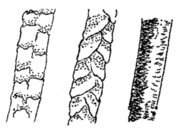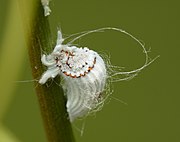Felted
This article may be too technical for most readers to understand. (December 2022) |

Felted is a term variously applied to hairy or otherwise filamentous material that is densely packed or tangled, forming felt or felt-like structures. Apart from fibres in felted fabric manufactured by humans, the term felted may apply to the condition of hair such as in the pathological condition known as felted hair, or it may apply to the tangled threads of the tissue of certain fungi, to matted fibres in animal connective tissue, or to the felted outer coat of certain plants. To say that something is felted need not imply that any processes of matting, condensing and pressing fibres have been applied as in the processes for artificial production of felt fabric. Depending on the nature of the felted material, it might rely purely on the scaly or barbed texture of the matted fibres to prevent unraveling, but commonly it will include clayey or sticky materials for its structural integrity, or for increased density.
Zoology


Examples of the description of animal tissues as felted include classes of connective tissue such as the dermis which the classic Gray's Anatomy describes as: "felted connective tissue, with a varying amount of elastic fibers and numerous bloodvessels, lymphatics, and nerves." Also, in describing the external coat or tunica adventitia of an artery, Gray says: "...consists mainly of fine and closely felted bundles of white connective tissue..."[1][page needed] In such classes of connective tissue the felted structure is very important; it is versatile in resisting tearing by distributing localised stresses and it imparts strength together with shock absorption and elasticity in two or three dimensions at once, irrespective of the shape of the tissue.[2][page needed] In other words, suitable types of felting can yield controllable isotropy or anisotropy in the behaviour of a structure.[3][page needed]
Other examples of felted material in animal structures include fibrous structures coating the integument of some insects. Usually such a felted coating is not living tissue, but consists of waxy fibres and is not particularly strong, but serves as protection from either excessive desiccation or moisture. It is particularly common in some families of the Hemiptera. In some species it occurs only as an outer coat of the immature insect, but in others, such as many of the Coccoidea, including the "Australian bug", Icerya purchasi and cochineal, Dactylopius species, it is secreted throughout the life of the insect and serves largely to protect the eggs rather than the insect.[4][pages needed] In other species, such as many of the woolly aphids, the Eriosomatinae, the most fluff is borne on the adult insect.[5][page needed]
The distinction between felted and other fibrous materials is not always sharp. For example, although truly felted hair on healthy mammals is unusual, many animals, especially in seasonally cold or wet climates or environments, often have a so-called undercoat of down hair plus awn hair that usually lies hidden beneath the outer coat of guard hairs,[6][page needed] and may form a mat of lightly felted wool. Such down hairs as a rule are crimped into a finely woolly texture and contain waxy, water-repellent lanolin; in a mass they serve to retain insulating air and exclude water. In many species that live in seasonally frigid zones the winter down hair is shed in clumps during springtime. This is exploited in species such as the muskox; herders collect the wool for commercial purposes without any need for shearing.[7][page needed]
Felting activities of animals
Many species of animals actively employ felting behaviour in preparing shelters for themselves or their young. It is not always possible to tell when such felting is purely incidental, but many species show behaviour patterns clearly adapted to the production of felted material suited to shelter and protection. The linings of nests of small rodents and small carnivores are common examples; some mice for example, such as ground-dwelling Mus species in parts of Africa, build spherical nests of assorted fibres in burrows or under large flat objects. Some, such as various species of rabbit, in particular Sylvilagus species, use their own fur as a major component of their nesting material.[8][pages needed] Small predatory mammals such the least weasel largely collect fur from their prey, or occupy prey nests ready lined; such fur commonly forms a felted nest lining.[9][page needed]

Birds vary in the nests they make and the materials they use. Among those that use fibres and fibrous materials such as grass for nesting, many tend to weave the nests, but even nests that initially are purely woven, such as those of weaver birds, later are lined with downy materials that largely become felted, both with each other and with the surrounding nest material. Similarly birds such as sparrows, that build large, twiggy nests, line them with downy material. Many kinds of birds however do little weaving in building their nests, but instead construct their nests mainly of fibrous and downy materials such as fine wool, moss, lichen, spiders' nests, tufts of cotton, arachnoid fluff from plants, or bark scales, supported by twigs or the walls of burrows and the like, depending on the circumstances within which they nest. Naturalist James Rennie remarked, "A circumstance also never neglected, is to bind the nest firmly into the forks of the bush where it is placed, by twining bands of moss, felted with wool, round all the contiguous branches, both below and at the sides."[citation needed] During the nesting season such birds commonly become such avid seekers of suitable materials that down feathers or tufts of wool may be used as bait for trapping them. Birds that concentrate heavily on felted nests include goldfinches (Carduelis species) and related species. Hummingbirds tend to use a lot of spider web together with moss and similar material. Small warbler-like birds of many genera such as Prinia and Cisticola make their nests either heavily lined with, or entirely of felted material.[10][pages needed][11][pages needed] Ground nesting birds often use felted material rather than woven; it usually suffices and some of the structures can be deceptively sophisticated. For example, the common eider, famous for the valuable down harvested from its abandoned nests, lays its eggs in very lightly felted bowls of its own down; simple though this seems, the thick, soft layer provides exceptional insulation.[citation needed]
Invertebrates




Various insects also create felted materials, generally forming part of the shelter for their young. Burying beetles are known for stripping the fur or feathers from the carcasses that they prepare for their young, and using the material to line and reinforce the crypt that they dig.[12][page needed] it is however unclear whether this habit is anything more than incidental, and also how relatively important it is in the different species of the genus. As long ago as the 19th century at least, Jean-Henri Fabre demonstrated that the species that he investigated most certainly did not depend on feathered or hairy food items, being quite able to utilise reptiles and amphibians and fishes.[13][page needed] However, there is no doubt about the use of felted fibre by various species of bees, in particular, those members of the Megachilidae that are known as carder bees build their nests mainly of plant fibre collected from arachnoid plants, though they also might add fibre from other sources, such as animal wool. The sheer amount of the material that they gather often is startling, bearing in mind that the species of bees are not at all large.[14][pages needed]
Some invertebrates other than insects construct felted structures. Among those spiders are the most conspicuous. Many or most spider egg cases are partly or largely felted silk as well as woven or wound. The lids of various species of trapdoor spider burrows vary in their construction, but they are largely of earth and similar material reinforced with partly felted silk.[citation needed]
Botany


In botany, felted is defined as "matted with intertwined hairs".[15] A felted covering is protective against grazing or browsing, wind, windblown sand, ultraviolet radiation, drought, and desiccation.[citation needed] An example is Cephalocereus senilis (old man cactus), which has radial spines that grow into a tangled coating of white hair, concealing the green tissue and the spines. The felt forms a protection against intense radiation, wind, frost, and herbivores of various sizes.[16][page needed] The woolly masses of fibres on such cacti have been used as stuffing for pillows.[17][page needed]
Mycology

Most fungal tissue is filamentous, predisposing it to grow into tangles that lend themselves to felting. Whereas vascular plants seldom have cells that grow into forms that can form massive tangles, fungi hardly can form tissues at all except by tangling and felting their hyphal filaments.[clarify] Most mushroom tissue, including cords and membranes, is formed of anastomosed and felted hyphae. The spots on the caps of Amanita muscaria consist of felted patches of remnant tissue from the volva.[18][pages needed]
References
- ^ Gray, Henry (1918). Anatomy of the Human Body. Revised by Warren H. Lewis (20th ed.). Philadelphia: Lea & Febiger. Retrieved 27 December 2022 – via Internet Archive.
- ^ Vogel, Steven (2000). "Chapter 5: The Stiff and the Soft". Cats' Paws And Catapults: Mechanical Worlds Of Nature And People. Penguin. ISBN 978-0140277333.
- ^ Gordon, J. E. (2003). Structures, Or Why Things Don't Fall Down. Da Capo. ISBN 978-0306812835.
- ^ Weaving, Alan; Picker, Mike; Griffiths, Charles Llewellyn (2003). Field Guide to Insects of South Africa. New Holland Publishers, Ltd. ISBN 1-86872-713-0.
- ^ Costa, James T. (2006). "Chapter 9". The Other Insect Societies. Belknap Press. ISBN 978-0674021631.
- ^ Robinson, Roy (1977). Genetics for Cat Breeders. Pergamon. ISBN 0-08-021209-3.
- ^ Feldhamer, George A. Mammalogy: Adaptation, Diversity, Ecology. The Johns Hopkins University. ISBN 978-0801886959.
- ^ Long, Charles A. (2008). The Wild Mammals of Wisconsin (Faunistica). Pensoft Publishers. ISBN 978-9546423139.
- ^ Jackson, Hartley H. T. (1961). Mammals of Wisconsin. University of Wisconsin. ISBN 978-0299021504.
- ^ Rennie, James (1845). "Chapter VIII". Natural history of birds : their architecture habits and faculties. New York: Harper – via Internet Archive.
- ^ Hockey, Phil; Ryan, Peter; Dean, Richard (2005). Roberts Birds of Southern Africa. John Voelcker Bird Book Fund. ISBN 9780620340533.
- ^ Burton, Maurice; Burton, Robert (2002). International Wildlife Encyclopedia. Marshall Cavendish. ISBN 978-0761472698.
- ^ Fabre, Jean-Henri (1919). The glow-worm and other beetles. Translated by Alexander Teixeira de Mattos. New York: Dodd, Mead and Company – via Internet Archive.
- ^ Fabre, Jean-Henri (1915). The Bramble-bees and others. Translated by Alexander Teixeira de Mattos. New York: Dodd, Mead and Company – via Internet Archive.
- ^ Jackson, Benjamin Daydon (1928). A Glossary of Botanic Terms with their Derivation and Accent (4th ed.). London: Gerald Duckworth & Co. Retrieved 27 December 2022 – via Biodiversity Heritage Library.
- ^ Mauseth, James D. (2006). "Structure–Function Relationships in Highly Modified Shoots of Cactaceae". Annals of Botany. 98 (5): 901–926. doi:10.1093/aob/mcl133.
- ^ Powell, A. Michael; Weedin, James F. (2004). Cacti of the Trans-Pecos and Adjacent Areas. Texas Tech University Press. ISBN 978-0896725317.
- ^ Moore, David; Robson, Geoffrey D.; Trinci, Anthony P. J. (2011). 21st Century Guidebook to Fungi. Cambridge University Press. ISBN 978-0521186957.
